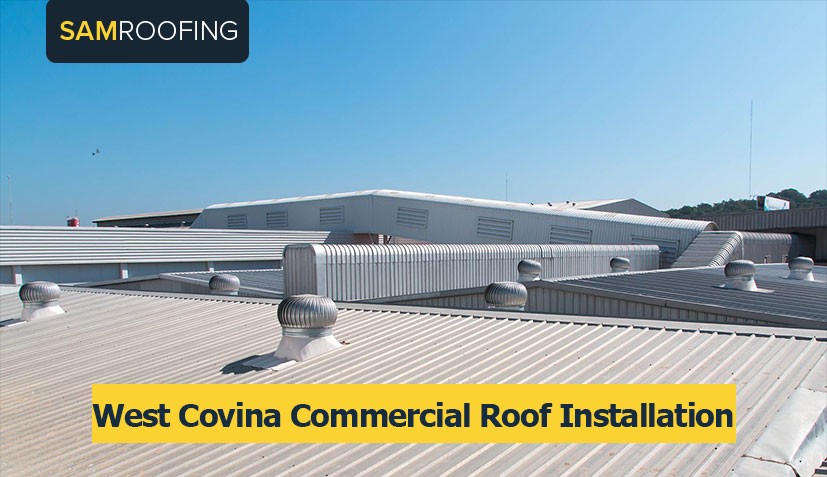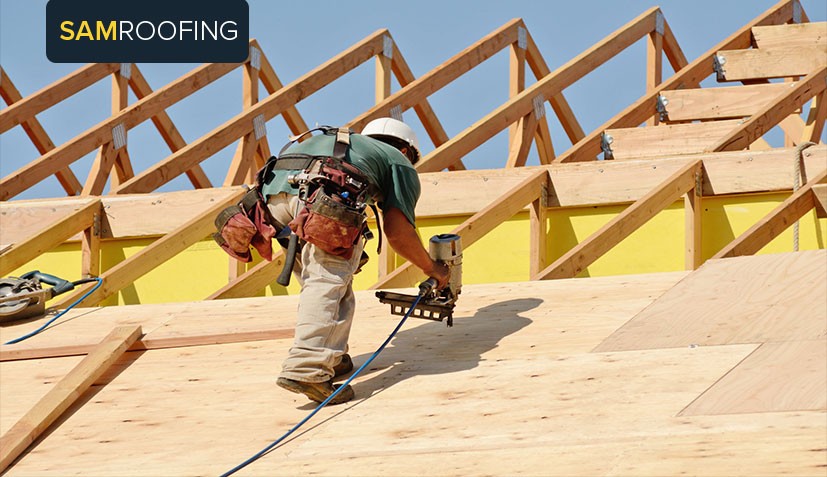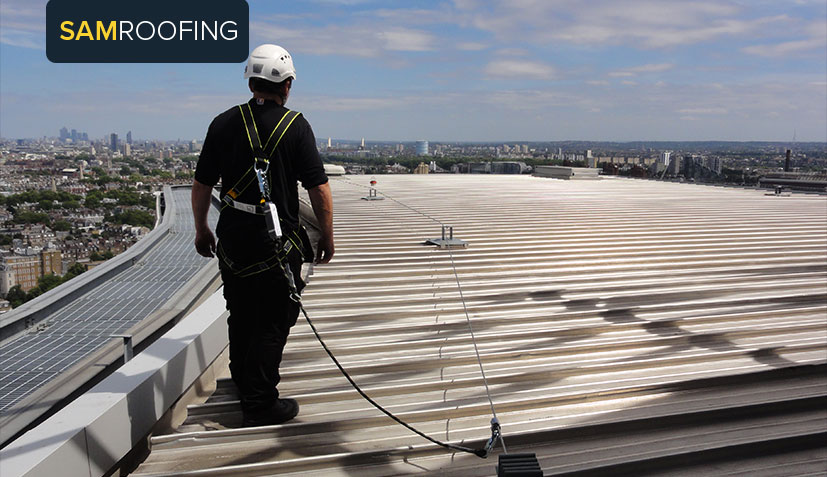West Covina Commercial Roof Installation
At Sam Roofing, we continuously strive to be the leading West Covina commercial roof installation company for business owners in West Covina.

Our top priority is giving our clients the best job we can do. We specialize in industrial and commercial roofing.
We are roofing professionals with years of expertise in the roofing business and are committed to giving our clients the greatest roofing options. Any roofing material on your business property may be installed, repaired, or replaced by our team of professionals. Call us for an appointment.
West Covina Commercial Roof Installation: What To Look Out For
Every roof has a life cycle and there comes a time when it makes sense to stop repairing and go in for a West Covina commercial roof installation.
Because installing a roof is often a large capital expense, we realize building and facility owners need to be comfortable with their decision.
Our goal is to make you feel confident enough to continue with the installation.
Which Roofing Solution is Right For Your Building?
Sam Roofing will provide a complete and honest evaluation in writing, as well as details of any problems noted on your roof. We will guide you on the best option based on your budget, building structure, and need.
Project logistics, site security, and any other construction-related concerns will be addressed, as well as the project’s estimated schedule and completion date.

How Long Should A New Commercial Roof Last?
Different roofing materials and roofing systems will have different life spans. The general lifespan of a professionally installed new roof can range from 15 to 35 years with proper maintenance and care. A neglected roof can start having problems sooner if care is not taken.
| Ethylene propylene diene terpolymer | These are known as EPDM roofs and can have a lifespan anywhere in the range of 22 to 35 years |
| Thermoplastic polyolefin | The TPO roof can last anywhere between 22 to 30 years |
| Metal roof | These roofs have a lifespan of 30 to 45 years |
| Polyvinyl chloride | These are also known as PVC roofs and have a lifespan of 20 to 30 years |
| Asphalt | This roofing material has a life expectancy of 20 to 40 years |
How We Work
- When we begin your commercial roof installation and arrive on site, we consider ourselves guests and behave as guests should. We inform each crew member of any special requirements before they arrive on-site to begin work. We treat your project, staff, and building as our own.
- After agreeing upon a plan and schedule, our men will begin the work. But, the communication continues once the work has started. If a problem arises, whether it’s the weather, unforeseen construction conditions, or an unexpected change in your operations, we’ll contact you and take whatever steps are necessary to accommodate the situation.
- Have any questions along the way? We will answer or address questions or concerns at any time and make adjustments promptly.
How we start
Once you’re ready to move forward, we’ll meet with you to determine a plan with the least disruption to your daily business. We will tailor our approach to suit the unique environment of your facility and work practices.
We will accommodate your security standards, business hours, parking limitations, building access, and other standards you may have. Whether you have a high-traffic urban retail location or a manufacturing or distribution center that operates 24 hours a day, we’ll accommodate your needs.
What to expect
West Covina commercial roof installation is a significant undertaking that requires careful planning and execution. There are several key steps involved in the process, which can vary depending on the size and complexity of the roof and the specific needs of the building. We will describe nine stages of a commercial roof installation project, from concept to completion.
Here is a brief description of the different steps of a West Covina commercial roof installation:
-
Assessing the Condition of the Existing Roof:
Before any work can begin, it is crucial to thoroughly assess the existing roof’s condition. This may involve physically inspecting the roof and reviewing any available documentation or records. This assessment is intended to identify any issues that need to be addressed as part of the roof installation process.
-
Site Assessment:
In addition to assessing the existing roof’s condition, we must thoroughly assess the site where the work will be performed. This includes evaluating the layout and grade of the property, as well as any potential obstructions or hazards that could affect the job, such as power lines, neighboring buildings, or nearby trees.
-
Develop a project plan:
Once the condition of the existing roof and job site has been assessed, it’s time to determine the best installation approach. In some cases, this may involve removing the existing roof and installing a new one on top of the existing structure.
In other cases, it may be more advantageous to build a new roof over portions of the existing structure while removing and rebuilding other sections from the deck upwards.
-
Selecting a material for the new roof:
Once the approach to the West Covina commercial roof installation has been determined, it is time to choose a material for the new roof. Commercial roof replacement will often be made with traditional flat roofing material such as EPDM rubber or modified bitumen.
However, Commercial or industrial buildings may also require products such as TPO, standing seam metal, or specialized commercial roofing material to replace the existing substrate (or deck).
-
Developing a plan:
Once the roof’s condition has been assessed, the next step is to create an installation plan. This may involve designing a new roof that meets the specific needs of the building, as well as considering any applicable building codes or regulations.
-
Obtaining Necessary Permits:
Depending on the scope of work for the West Covina commercial roof installation, obtaining various permits from local government jurisdictions may be necessary before beginning the roof installation process. This usually includes a building permit and any other permits that may be required for the specific type of work being done.
-
Remove the Existing Roof:
The next step is to remove the existing roof. This may involve tearing up old roofing materials, disposing of them properly, and removing any debris accumulated on the roof.
-
New West Covina Commercial Roof Installation:
Once the old roof has been removed, the next step is to install the new roof. This may involve laying down a new underlayment, new roofing materials and installing flashing. Depending on the specific type of roof installed, ventilation systems or other components may also be installed at this time.
-
Completion of Work:
After the new roof installation has been completed, the final step is to finish the remaining work and tidy up the site. This may include cleaning up any debris or materials generated during the roof installation and performing necessary tests or inspections.
In general, West Covina commercial roof installation is a complex process that requires specialized skills and knowledge. Therefore, working with a qualified and experienced contractor is essential to ensure the job is done correctly and safely.
West Covina Commercial Roof Installation Systems

Installing a roof on a new commercial building is quite simple from a procedural standpoint. However, some differences in the installation of the roofing systems must be addressed.
Installation of the TPO, PVC, and EPDM membrane system
Also known as single-ply roofing systems, these systems require fewer steps and install with a relatively simple process:
- The roof is cleaned of any material that could damage the membrane.
- The membrane is spread over the roof (single-ply roofing usually comes in rolls)
- The membrane is then attached to the roof with tape, glue, or heat (for thermoplastic material)
- The membrane is also adhered to itself where its edges overlap
- Bumps or protrusions are sealed
The time it takes to install a membrane or single-ply roofing system will also depend on the width of the material. The wider the material, the fewer seams there are in the roofing system, which also translates to fewer opportunities for leaks and roof failure.
Installation of the BUR/asphalt system
Built-up roofing systems are among the most traditional types of roofing used today. BUR systems are strong, attractive, and effective for stopping leaks and fending off water. Four steps make up the installation process:
- Base sheets are laid and attached to the roof deck.
- The felt is glued to the base sheets with adhesive, concrete, asphalt, or tar.
- Gravel or top layers are installed over the felt.
- A final layer of asphalt completes the installation process
A properly installed BUR system creates a virtually impenetrable roof, capable of preventing severe weather and the elements from entering the building it protects.
Installation of the Modified Bitumen System
Modified bitumen is an evolution of asphalt roofing, a form of flat membrane roofing. The roofing system can withstand considerable foot traffic without wear and tear. The following are the installation processes for torch-down modified bitumen roofing systems:
Torch-Down Modified Bitumen:
- The roof is cleared of debris
- Heavy roofing felt is installed and nailed.
- Flashing and primer are installed
- The first sheet is extended along the edge of the roof (trimmed and adjusted)
- The sheet is rolled back up
- A torch is used to melt the bitumen slightly
- Overlapping sheets are applied similarly until the roof is covered and sealed.
Installation of metal panel roofing system
Metal roofing is one of the most costly solutions, but it is also one of the most long-lasting (up to 40 years). Here is how a metal roofing system is installed:
- The existing roof may need to be removed (depending on municipal codes and/or roof load capacity)
- The roof deck is prepared (framing and insulation installation)
- Flashing and eaves are installed.
- The metal panels are placed and fastened to the roof (how they are fastened depends on the material the panels are made of – aluminium, copper, steel, etc.)
The metal roof can be installed using panels or steel shingles. Steel shingles are installed similarly to slate, clay, or concrete tiles.
Sam Roofing is one of West Covina’s leading commercial roofing companies, with years of experience helping businesses succeed with a commercial roof replacement. So if you’re looking for a reliable and experienced company to help you with your commercial roof installation project, let’s start the conversation today!
FAQ
Which types of roofs are typically installed on commercial buildings?
Most commercial properties have flat or low-sloping roofs. It is easier to install this type of roof.
What are the important things to consider for a commercial roof installation?
-
Roof access
-
Membrane choice
-
Roof penetration
Which roof type will best suit my commercial property?
We can only answer this question after getting to know about your specific commercial property location. Here are some factors to consider before choosing a commercial roofing material.
-
Climate
-
Energy costs
-
Facility needs
How do I know if my commercial property needs a new roof?
We provide roof inspection services and will quickly bring to your notice if there is an impending danger. With your permission, we will then install a new roof.